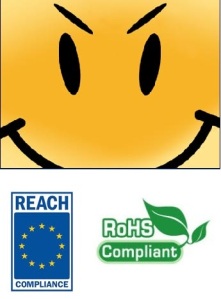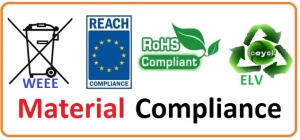Archive
Dear Stakeholder, beware of Material Compliance Directives !
Dear Stakeholder, beware of Material Compliance Directives or else PAY for it !
Of late, Sustainability is a buzz word for the OEMs and Suppliers ever since global warming was discovered as a threat to our beloved earth. I tried to google more about various regulatory compliance directives followed across geographies and to my surprise I had to browse several websites to find out all the norms followed and I felt its wise to collate general information about compliance in one place and again based on my understanding I thought of putting into perspective when is the right time to introduce material compliance as a PLM solution in the Product development phase.
First of all lets see what are the various compliance directives or norms or definitions available as of today:
Restriction of Hazardous Substances(RoHS) pronounced as “ros”
RoHS is often referred to as the lead-free directive,along with lead it also restricts the use of the five more substances:
- Lead (Pb)
- Mercury (Hg)
- Cadmium (Cd)
- Hexavalent chromium (Cr6+)
- Polybrominated biphenyls (PBB)
- Polybrominated diphenyl ether (PBDE)
Everything that can be identified as a homogeneous material must meet the limit. Homogeneous here refers to individual substance, all of the same or similar kind or nature or that can be separated mechanically. The maximum permitted concentrations are 0.1% or 1000 ppm(Parts Per Million) by weight of homogeneous material. This means that the limits do not apply to the weight of the finished or end product but applies to single substance that could (theoretically) be separated mechanically — For instance, a circuit board is composed of PCB, ICs, resistors, capacitors, switches, etc. The limit(0.1%) is applied on individual similar substances.
RoHS started by European Union is a mandatory norm for 25 countries like Austria, Latvia, Belgium, Lithuania, Bulgaria, Luxembourg, Cyprus, Malta, CzechRepublic, Netherlands, Denmark, Poland, Estonia, Portugal, Finland, Romania, France, Slovakia, Germany, Slovenia, Greece, Spain, Hungary, Sweden, Ireland, United Kingdom and Italy.
RoHS directives are also adopted by –
- California RoHS – January 07
- China RoHS – March 07
- Korea RoHS – July 07
- Japan RoHS
- Taiwan RoHS
RoHS is mainly applicable for High-Tech,Semiconductor,etc.
Waste Electrical and Electronic Equipment Directive(WEEE) pronounced as “we”
WEEE directive imposes the responsibility for the disposal of waste electrical and electronic equipment on the manufacturers of such equipment. Those OEMs and Suppliers should establish an infrastructure for collecting WEEE, in such a way that “Users of electrical and electronic equipment from private households should have the possibility of returning WEEE at least free of charge”. Also, the OEMs and Suppliers are compelled to use the collected waste in an ecologically-friendly manner, either by ecological disposal or by reuse/refurbishment of the collected WEEE. One important thing to note over here is that the consumers return their used e-waste free of charge.
Despite such rules on collection and recycling only one third of electrical and electronic waste in the European Union is reported as separately collected and appropriately treated. A part of the other two thirds is potentially still going to landfills and to sub-standard treatment sites in or outside the European Union.
WEEE is mainly applicable to High-Tech industry.
Registration, Evaluation, Authorisation and Restriction of Chemicals(REACH) pronounced as reech
REACH entered into force on 1st June 2007. It streamlines and improves the former legislative framework on chemicals of the European Union (EU). The main aims of REACH are to ensure a high level of protection of human health and the environment from the risks that can be posed by chemicals, the promotion of alternative test methods, the free circulation of substances on the internal market and enhancing competitiveness and innovation.
REACH makes industry responsible for assessing and managing the risks posed by chemicals and providing appropriate safety information to their users. In parallel, the European Union can take additional measures on highly dangerous substances, where there is a need for complementing action at EU level.
REACH is applicable to most of the industries which includes High-Tech,Automotive,Industrial Equipment, Aerospace & Defense, Consumer Goods etc.
End of Life Vehicle(ELV)
ELV lays down specific requirements for the management of end-of-life vehicles. The Directive’s main objective is the prevention of waste from vehicles and, in addition to this, the reuse, recycling and other forms of recovery of end-of-life vehicles and their components so as to reduce the disposal of waste. The Directive also aims to improve the environmental performance of all economic operators involved in the life-cycle of vehicles and especially the operators directly involved in the treatment of end-of-life vehicles.
The directive aims to make vehicle dismantling and recycling more environmentally friendly,also set clear quantified targets for reuse, recycling and recovery of vehicles and encourages producers to manufacture new vehicles which are easy to recycle.
ELV is mainly applicable to Automotive industry.
If you are aware of any other Material Compliance directives please direct me to those links.
When to introduce Material Compliance?
Compliance can be and should be introduced in the Product Conception or Product Definition phase and also what goes into the actual product can be monitored during Product Design phase. To a great extent compliance can also be at the back of your mind during the Testing or Simulation of the product and of course compliance matters most during Manufacturing of the product, transportation and also very importantly End of Life of the product where the waste management becomes a very important aspect in adhering to product compliance. If you observe closely everything mentioned so far can run in a cycle(Conception-Design-Testing-Manufacturing-Waste-Conception) and its obvious that more the number of cycles the same material goes through, its quite an indicative factor that the manufacturer is introducing a highly compliant product to the market.
If you are aware of any other directives apart from the directives mentioned above, please direct me to those links.
To summarize, its a fact that human population by virtue of their wants and needs have already thrown huge amount of harmful substance into the atmosphere across the globe and it becomes highly important to put a break or minimize the usage of these harmful substances and be wise to reuse or recycle the wastes.
ENOVIA Material Compliance solution is one such product which can come to the rescue of the product stakeholders. Try this product at a very early stage of your product development and reap benefits effortlessly.
For further information about the compliance solution please visit ENOVIA ->Governance-> Compliancy.
Best Regards, Ajit
55 percent of the seafood in Walmart stores is certified! ! !
Yes ! ! !
At least 55 percent of the seafood in Walmart stores is certified as having been caught with sustainable fishing practices, all its large electronics equipment and personal computers are manufactured without hazardous materials.
Wow…!!!
Walmart is one such retailer who have completely changed the way they handle logistics, operations, and sales practices. This has naturally altered the mindsets of consumers making them all the more cautious of what they consume and their buying habits have witnessed a drastic shift. Consumers are now more aware and are demanding for greener products. Surely a right way to go isn’t it !

Material Compliance Management
We have already started to see such a growing awareness among consumers and without any second thoughts I believe its the consumers who would be key drivers in making product companies adopt compliancy without any kind of ignorance.
While most of the companies have started viewing Materials Compliance as a means to fulfill Corporate Social Responsibilities, a few others have ignored. For instance sometime back it was estimated that the value of noncompliant automotive aftermarket parts exported to the United States exceeded $2.7 billion. A real worry ! ! !
In a highly competitive consumer market following compliance and bringing greener and sustainable products to the market is the need of the hour and also an important survival startegy.
Walmart Fish store is quite an inspiration ! ! !
So, how Materials Compliance solution help companies???
1.Enables to build trustworthy products
2.Provides a competitive differentiation in the market
3.Promotes product innovation
4.Helps branding on the grounds of sustainable products
5.Very importantly helps avoiding penalties from government or regulatory bodies
The companies are at greater advantage when compliance is implimented earlier in the design phase of the products thereby minimizing percolating costs if implimented at a later stage.
Dassault Systemes ENOVIA Material Compliance Central provides a comprehensive compliance solution that enables companies to track, analyze, and report a product’s environmental compliance.
For more information please click here
Wishing You A Very Happy New Year 2011 ! ! !
Best Regards, Ajit
